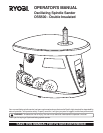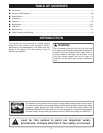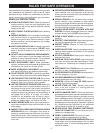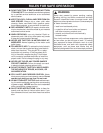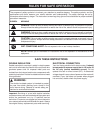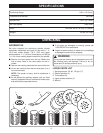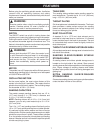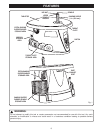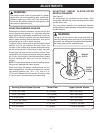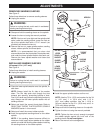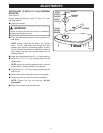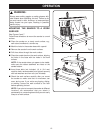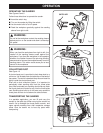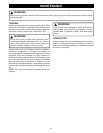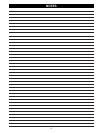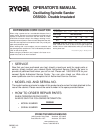
3
RULES FOR SAFE OPERATION
Safe operation of this power tool requires that you read
and understand this operator's manual and all labels
affixed to the tool. Safety is a combination of common
sense, staying alert, and knowing how your tool works.
READ ALL INSTRUCTIONS
■ KNOW YOUR POWER TOOL. Read the operator's
manual carefully. Learn the tool's applications and
limitations as well as the specific potential hazards
related to this tool.
■ KEEP THROAT PLATES IN PLACE and in working
order.
■ REMOVE WRENCH. Get in the habit of checking to
see that the wrench is removed from the spindle
before turning on the tool. Return the wrench, upper
spindle washer(s), and throat plates to the storage
area when not in use.
■ KEEP WORK AREA CLEAN. Cluttered work areas
and work benches invite accidents. DO NOT leave
tools or pieces of wood on the tool while it is in
operation.
■ DO NOT USE IN DANGEROUS ENVIRONMENTS.
Work in a well lit area. Do not use power tools near
gasoline or other flammable liquids. Do not expose
power tools to rain or damp or wet conditions.
■ KEEP BYSTANDERS AWAY. Keep bystanders,
children, and pets away while operating a power tool.
Distractions can cause you to lose control.
■ MAKE WORKSHOP CHILDPROOF with padlocks
and master switches or by removing starter keys.
■ DO NOT FORCE THE TOOL. It will do the job better
and more safely at the rate for which it was designed.
■ USE THE RIGHT TOOL FOR THE JOB. Do not force
the tool or attachment to do a job for which it was not
designed. Use it only the way it was intended.
■ USE THE PROPER EXTENSION CORD. Make sure
your extension cord is in good condition. Use only a
cord heavy enough to carry the current your product
will draw. An undersized cord will cause a drop in line
voltage resulting in loss of power and overheating. A
wire gage size (A.W.G.) of at least 16 is recom-
mended for an extension cord 25 feet or less in
length. If in doubt, use the next heavier gage. The
smaller the gage number, the heavier the cord.
■ DO NOT ABUSE CORD. Never yank cord to discon-
nect it from receptacle. Keep cord from heat, oil, and
sharp edges.
■ INSPECT TOOL CORDS AND EXTENSION CORDS
PERIODICALLY and, if damaged, have them re-
paired by a qualified service technician at an autho-
rized service center. Stay constantly aware of cord
location and keep it well away from the moving parts
of the tool.
■ USE OUTDOOR EXTENSION CORDS. When tool is
used outdoors, use only extension cords with ap-
proved ground connection that are intended for use
outdoors and so marked.
■ DRESS PROPERLY. Do not wear loose clothing,
gloves, neckties, rings, bracelets, or other jewelry
that can get caught and draw you into moving parts.
Nonslip footwear is recommended. Also wear protec-
tive hair covering to contain long hair.
■ ALWAYS WEAR SAFETY GLASSES WITH SIDE
SHIELDS. Everyday eyeglasses have only impact-
resistant lenses, they are NOT safety glasses.
■ WEAR A DUST MASK to keep from inhaling fine
particles.
■ PROTECT YOUR HEARING. Wear hearing protec-
tion during extended periods of operation.
■ INSPECT WORK. Remove all nails from lumber
before sanding.
■ DIRECTION OF FEED. Feed the workpiece into the
sanding sleeve against the direction of the sanding
sleeve rotation only.
■ DO NOT OVERREACH. Keep proper footing and
balance at all times.
■ MAINTAIN TOOLS WITH CARE. Keep tools sharp
and clean for better and safer performance. Follow
instructions for lubricating and changing accesso-
ries.
■ DISCONNECT ALL TOOLS when not in use, before
servicing, or when changing attachments.
■ AVOID ACCIDENTAL STARTING. Be sure switch is
off when plugging in any tool.
■ USE RECOMMENDED ACCESSORIES. Using im-
proper accessories may risk injury.
■ MAINTAIN 1/16 in. (1.6 mm) OR LESS between
sanding drum and throat plate.
■ NEVER STAND ON TOOL. Serious injury could
occur if the tool is tipped or if moving parts are
unintentionally contacted.
■ CHECK DAMAGED PARTS. Check any previously
damaged parts for proper operation and performance.
Check alignment of moving parts, binding of moving
parts, breakage of parts, tool stability, mounting and
any other conditions that may affect its operation. A
damaged part must be properly repaired or replaced
by a qualified service technician at an authorized
service center to avoid risk of personal injury.
■ NEVER LEAVE TOOL RUNNING UNATTENDED.
TURN THE POWER OFF. Do not leave tool until it
comes to a complete stop.
■ FIRMLY CLAMP OR BOLT the tool to a work-
bench or table at approximately hip height.
■ KEEP HANDS AWAY FROM SANDING AREA. Keep
hands away from the sanding sleeve. Do not reach
underneath work or around sanding sleeve while
spindle is rotating.



